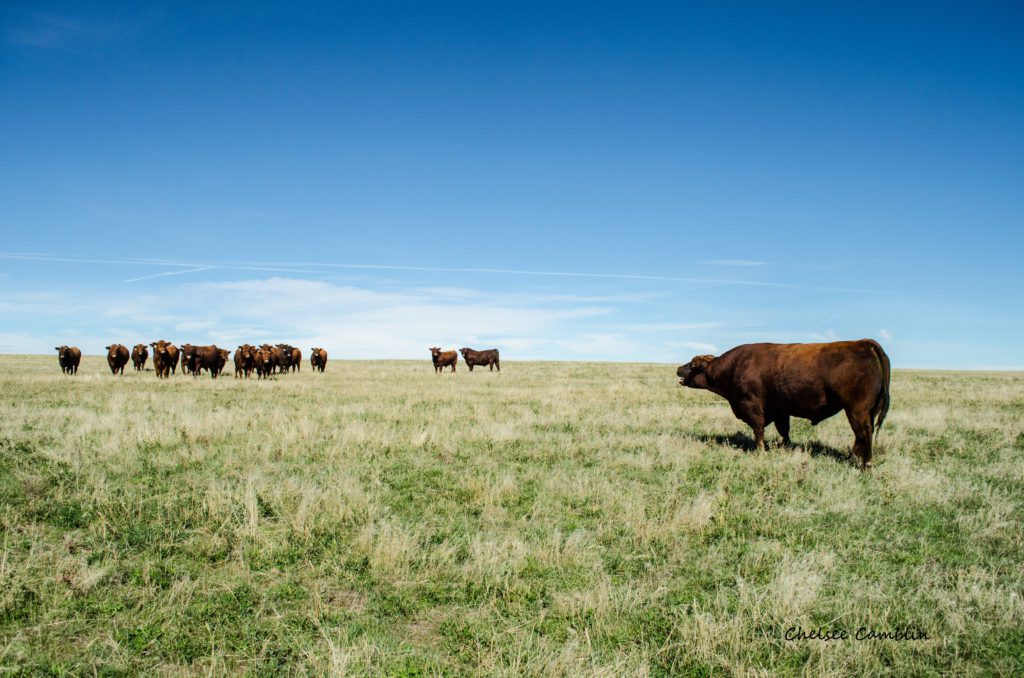Testing and organizing hay by quality and nutritional content can help make sure cows are getting their nutritional needs met at the right times.
Haying season is over, the days are getting shorter, and temperatures are cooler. Fall is here and winter is just around the corner. Beef producers will keep cows grazing as long as they can because grazing is cheaper than feeding harvested hays and forages. Depending on stage of production, supplements can be fed to take care of any nutrient gaps. Dormant range, cool-season pasture, and cornstalks are good winter feed resources as long as grazing recommendations (https://beef.unl.edu/keys-corn-stalk-grazing) are followed. At some time during the winter and before pastures can be grazed next spring, there is a good chance that harvested hays will be part of the menu for the beef herd. Now is a good time to get the harvested hays component organized.
Sampling Hay
Contact the lab that you will send the hay samples to. The lab often provides plastic bags to put samples in (a quart zip lock will do just fine too), an information sheet identifying the hay type, analysis you want the testing lab to perform, and billing and contact information.
For harvested forages like hay, use a hay probe to collect the sample for an accurate assessment. Most extension offices have a hay probe that can be checked out. Sample each hay by lot (https://beef.unl.edu/beefwatch/2021/test-don%E2%80%99t-guess-sampling-and-testing-hay). A lot is hay harvested at a similar time, from the same plant type and growth stage, and from a similar location such as a field. Because hay quality can vary due to differences from all the listed factors, sampling by lot ensures that a representative sample is provided for testing.
For most hays, 20 subsamples should be taken per lot and then mixed before the sample bag is filled and submitted to the laboratory. This helps capture variation in the hay. When sampling, try to take samples at random from bales. Don’t seek out good spots or avoid bad ones as this can skew results providing an inaccurate assessment of the hay quality.
Testing Hay
The most cost-effective analysis for most hays is a NIRS analysis (https://beef.unl.edu/stories/200810021.shtml). For this type of analysis, it is important to identify the sample (alfalfa, summer annual, prairie hay, bromegrass, etc.). Most common hays have a robust NIRS database for labs to pull from, but complex mixtures or rare hay types may still be best analyzed using traditional wet chemistry. If you have any questions, reach out to your lab of choice before submitting for confirmation on types of analysis (NIRS, wet chemistry) to use.
If hays will be fed to beef cows, test for moisture, percent crude protein, and total digestible nutrients (TDN). TDN cannot be directly tested but is a calculated value. You can request minerals as part of your NIRS analysis. If there is a need to test for other minerals, the lab can do that using another testing procedure. Summer annuals should also be tested for nitrates.
Hay Inventory
Inventory hays by type (alfalfa, grass hay, summer annual, etc.). Inventory each hay type by quality, including high (percent crude protein and percent TDN), moderate, and low. Count the number of bales by type and quality. Take a weight of each hay type by quality and calculate total pounds of each type. This will help determine the number of feeding days for each hay type and quality. Cows will eat more of the high-quality hay compared to the moderate and low-quality hay because it is easier to digest.
Cows will eat between 2.0 and 2.5 percent of their body weight on a dry matter basis (https://beef.unl.edu/cattleproduction/forageconsumed-day). As you budget the amount of hay needed, account for storage losses (10% to 25%) and feeding losses (10%). It is important to store hays in such a way to reduce storage losses. Store big round bales on the round side with space between them and not in low places where water settles. Additionally, limit or control (by mowing) the growth of weeds around the bales.
The following calculations will help you determine the amount of hay to budget per cow. If cows, on average weigh 1,200 pounds and the hay quality is moderate to high, each cow will eat 30 lb per day. When accounting for feeding losses (10%), this calculates to 33 lb per head per day on a dry matter basis. To determine the amount needed on an “as-fed” basis, look at the hay analysis to get the dry matter content. If the moisture content is 15%, then the dry matter content is 85%. Most baled hays will be between 84% and 90% dry matter. Divide 33 lb/hd/day by 0.85 to determine pounds per head per day “as-fed”. For this example, the amount is 39 pounds per head per day. If storage losses are 15%, you will need to budget 45 pounds per head per day.
Staging Hay
With inventory complete, consider organizing the stackyard by hay and forage quality. Stage by type (alfalfa, grass hay, summer annual, etc.) and quality. If some hays like summer annuals are high in nitrates, make sure you know where these hays are in the stackyard because they need to be diluted with other hays to be fed at a safe level. Consider identifying these bales by spray painting the bale wrap with a N. Organize the bales in the stackyard, so that you can easily get to each hay quality and type. Work with your Extension Educator or nutritionist to determine when and what to supplement when the hay doesn’t meet the cow’s nutrient requirements based on her stage of production (stage of gestation and stage of lactation).
Source: University of Nebraska- Lincoln Institute of Agriculture and Natural Resources (UNL Beef), Rick Rasby, Nebraska Extension Specialist
| Ben Beckman, Nebraska Extension Educator
Photo: Troy Walz.








